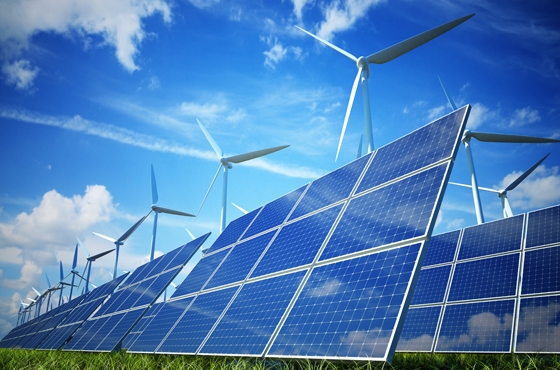While worldwide renewable energy investment was 12 percent lower in 2012 compared with 2011, investment in the sector in the Middle East and North Africa (MENA) region grew by 40 percent, industry officials said at a policy discussion held in Abu Dhabi on Sunday about the findings of the MENA Renewables Status Report 2013.
Regional investment in fact topped $2.9 billion and officials agreed that this indicated the transformation of the sector from a niche interest to a regional phenomenon.
The renewable energy market in the Middle East and North Africa (MENA) region is expanding rapidly, with a diverse range of countries announcing projects and policies to harness the region's abundance of renewable energy resources for economic growth and energy security enhancement. While capacity additions and investment remain below those of other regions, recent years have seen a groundswell of government and commercial interest.
The MENA region currently has 380.24 megawatts (MW) of installed solar photovoltaic capacity, 182 MW of concentrated solar power, 1.1 GW of wind power, 73.5 MW of power generated from biomass and waste, and 17.6 GW of hydropower.
The MENA Renewables Status Report 2013, developed by the International Renewable Energy Agency (Irena), the Renewable Energy Policy Network for the 21st century (REN21) and the Directorate of Energy and Climate Change at the UAE Ministry of Foreign Affairs, is an outcome of the Abu Dhabi International Renewable Energy Conference held in January.
The report noted more than 100 renewable energy projects, including solar, wind and biomass, are under development in the region at present. These could increase non-hydro renewable energy generating capacity by 450 percent in the next few years. In addition, announcements by various MENA governments indicate that additional capacity of 107 gigawatts (GW) could be established by 2030, representing a 60-fold growth to available capacity today.
The MENA region's Total Primary Energy Supply (TPES) reached about 800 million tons of oil equivalent (Mtoe) in 2010. This was an increase of 14.9 percent compared to 2007 (15.3 percent in the Net Oil-Exporting Countries (NOEC) and 10.5 percent in the Net Oil-Importing Countries (NOIC), respectively), or an average annual growth of 4.7 percent over the period. Increased energy consumption in the region is due largely to population growth, with related increases in demand for liquid fuels and electricity for domestic use and devices, heating, cooling, and desalination of water. Renewable energy use increased 27.6 percent in the NOIC from 2007 to 2010, and gained market shares over conventional energy sources.
The share of renewable energy in the MENA region's TPES remained about 1 percent from 2007 to 2010, with the dominant renewable energy sources being hydropower for electricity generation and traditional biomass for cooking and heating.
It is interesting to note, however, that in the NOIC the share of renewables increased from about 5 percent in 2007 to almost 6 percent in 2010, led by renewables use in Tunisia (14 percent of total energy), Israel, and Morocco (approximately 5 percent each).
The trend is already evident in recent data. In 2011, power generation reached about 1,200 TWh in the MENA region, a 20 percent increase compared to 2008. The share of renewable energy reached 3.3 percent, an increase of 0.4 percent percentage points, over the same period. While this may be seen as small progress, it must be noted that renewable power generation gained shares over conventional power sources despite a strong growth in electricity demand, which makes this growth meaningful and worth highlighting. More recently, Morocco, Lebanon, and Tunisia saw their renewable energy shares increase by at least 4 percentage points in the last two years, to reach 33 percent, nearly 12 percent, and 6 percent, respectively, in 2012.
Both NOEC and NOIC generate approximately the same share of their electricity from renewables. However, only 5 percent of the renewable power in the NOEC is generated from modern renewables, whereas this share reaches 28 percent in the NOIC. Nevertheless, in both the NOEC and the NOIC, modern renewable electricity production has risen at a much faster rate than conventional energy sources since 2008. Solar has seen the highest average annual growth in power generation in the region.
Growth in renewable energy generation is now occurring in both the NOIC and the NOEC, albeit for different reasons. In the NOIC, energy security and reduced dependence on expensive imported oil are key priorities, resulting in the highest renewable energy growth rates to date. In the NOEC, there is growing recognition of the opportunity cost of oil and gas used for domestic purposes, especially electricity production, desalination, and air conditioning, all of which are experiencing rapid increases in demand, driven by rising GDP, urbanization, and population growth in much of the region. In terms of absolute numbers, hydropower remains the primary renewable energy source for power generation in the region today.
Iran and Egypt are leaders in installed capacity with 9.5 GW and 2.8 GW, respectively. Other countries with over 1 GW of installed capacity are Iraq, Morocco, and Syria. Hydropower generation showed increase of almost 30 percent from 2008 to 2011 (9 percent average annual growth rate), 11 percentage points more than fossil fuel sources.
The Saudi Gazette
26 June






















































